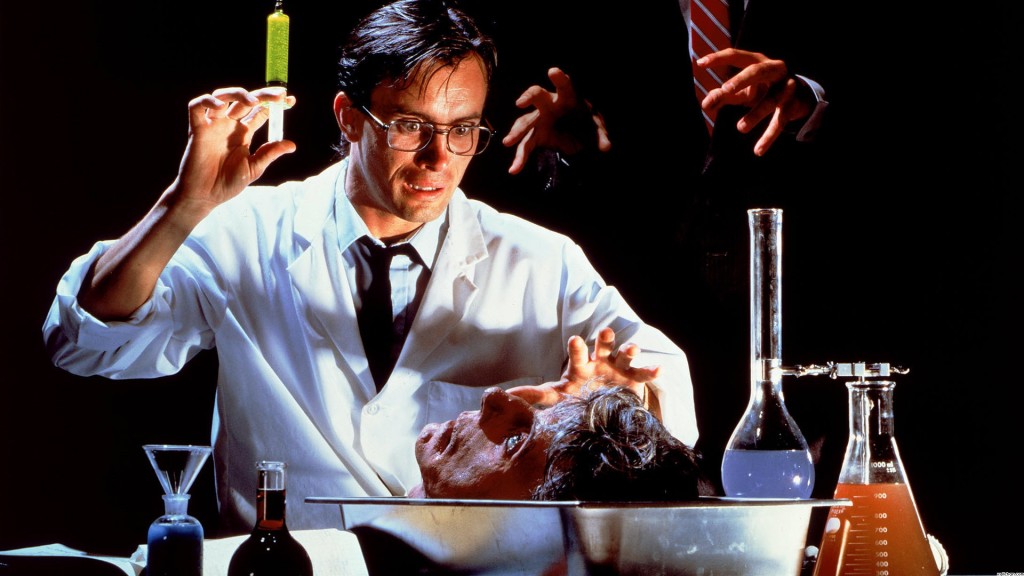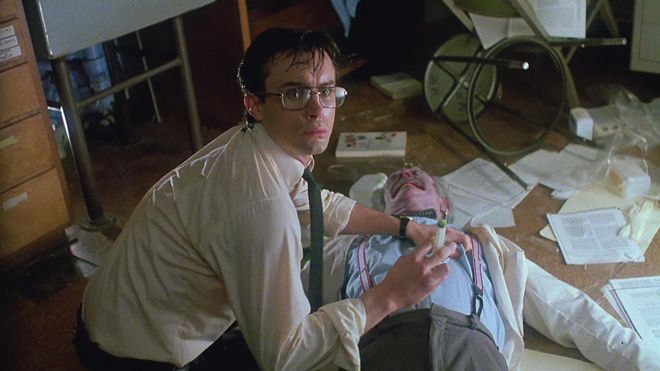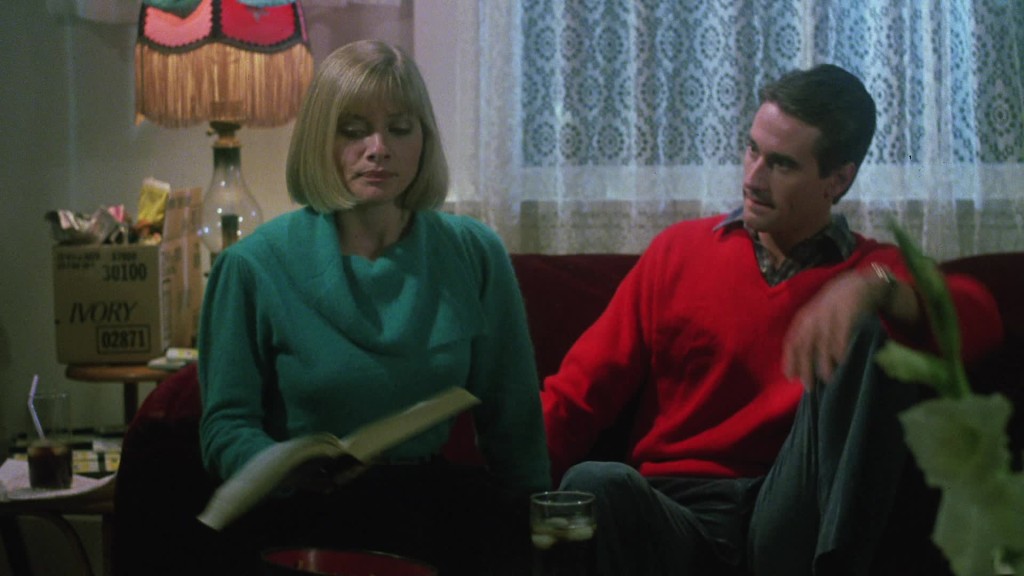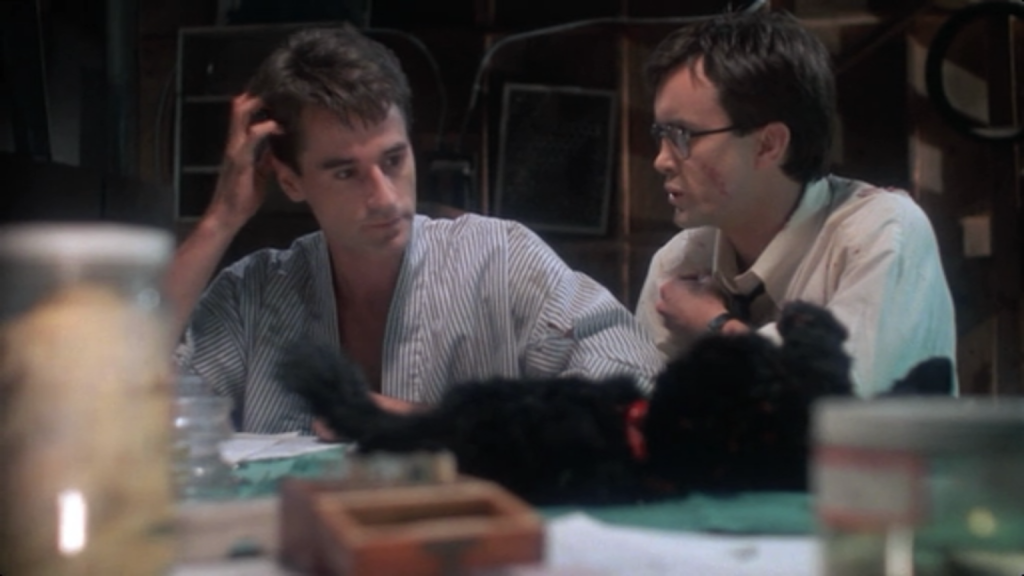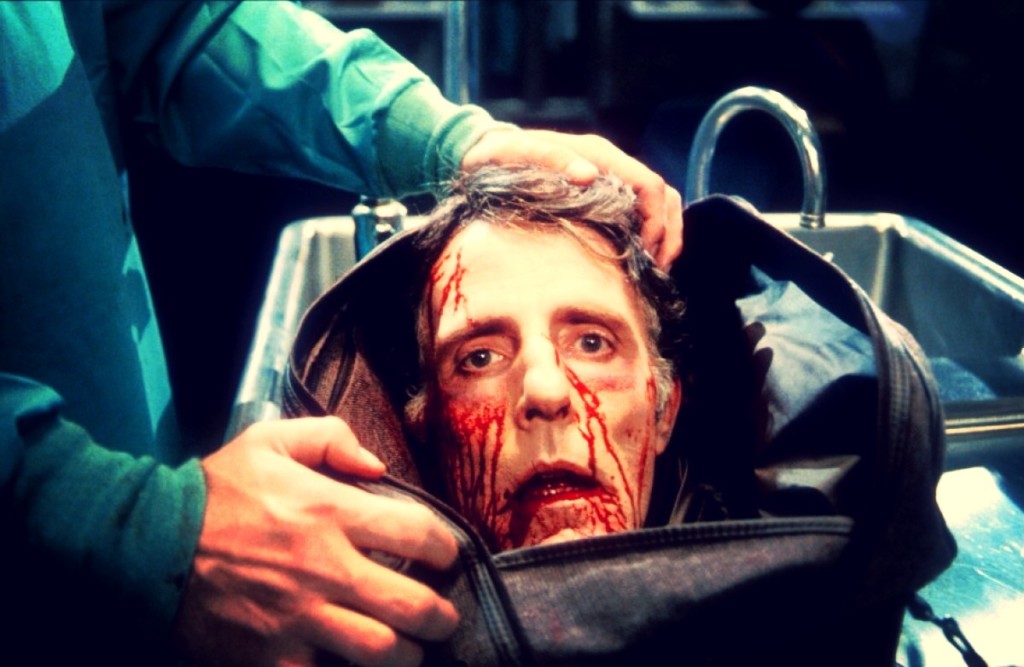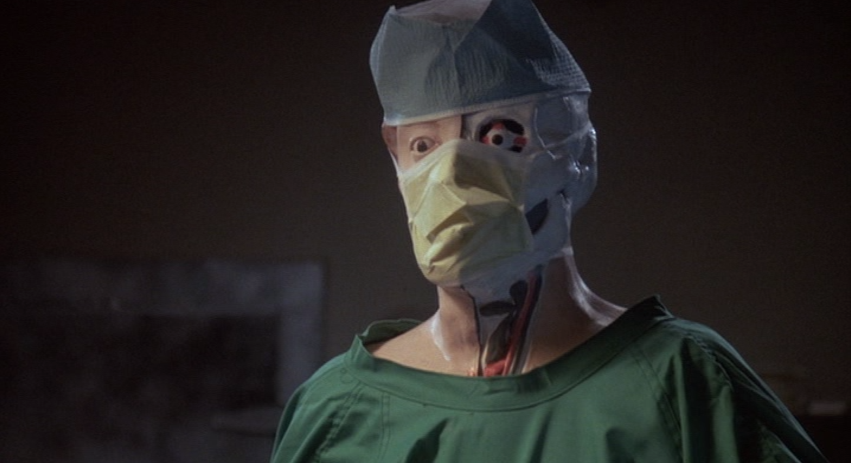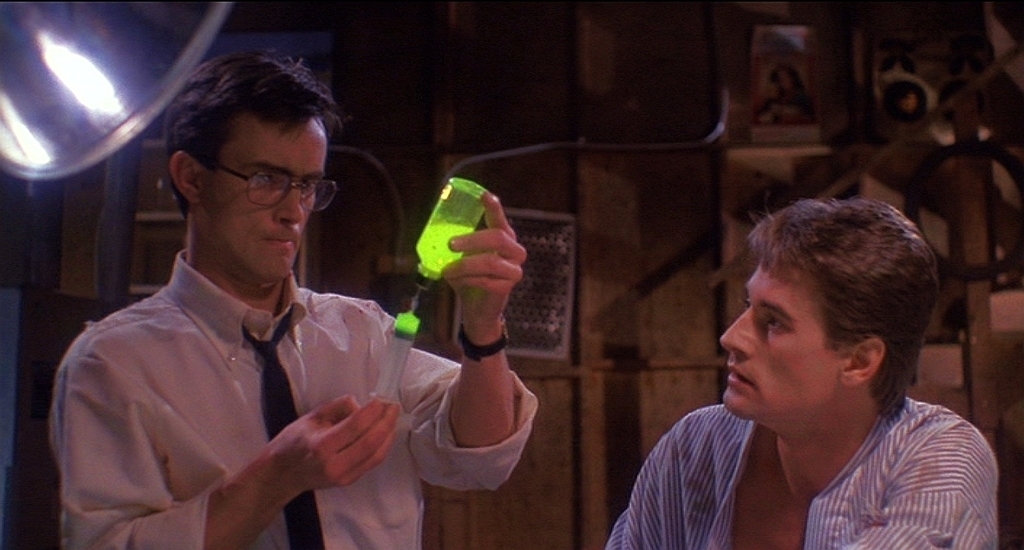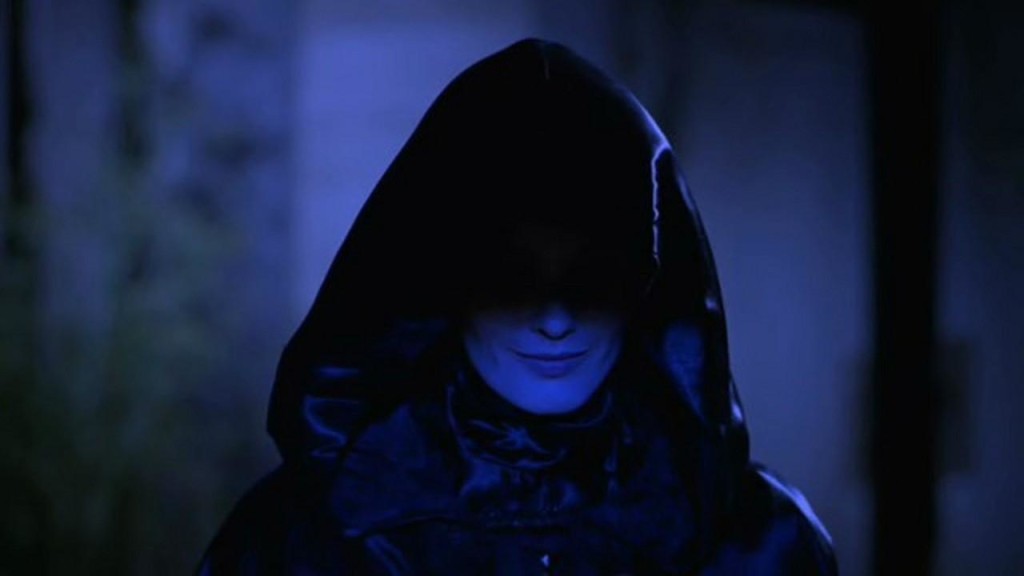
Lemora? Or really effective Assassin’s Creed cosplay? You decide!
This January, in support of the Toronto Rape Crisis Centre / Multicultural Women Against Rape, friends and family have raised over $1,000, which means I have to watch and write about thirty-one horror movies. I’ll watch (on average) one movie a night, many of them requested by donors, after which I’ll write some things about said movies on this website. Be forewarned that all such write-ups will contain spoilers! My most recent movie was Lemora: A Child’s Tale of the Supernatural, directed by Richard Blackburn (co-writer and associate producer of Eating Raoul), and requested by friend and donor David Summers. David is, without exaggeration, the friend of mine (excluding actual film programmers) who has the most extensive knowledge of horror movies – possibly just movies, in general. So when he recommended several horror movies for this project, I listened eagerly. (I’ll be watching another of his recommendations later this month.) I picked up mid-seventies horror curiosity Lemora from Bay Street Video.
What happens:
Lemora: A Child’s Tale of the Supernatural, set in the Depression-era South, opens with a bang. A pinstriped gangster, who we later learn is the infamous Alvin Lee (William Whitton) bursts into the bedroom where his wife is mid-affair with another man. With his shotgun, he shoots the man in the neck, then shoots his wife without hesitation. In his getaway, he accidentally runs over a woman on the street. Elsewhere, an angelic young blonde girl sings hymns in a church choir. Once she has finished, the Reverend (Richard Blackburn), dressed more or less like Colonel Sanders, announces to the entirely female congregation that he will talk about good and evil. Specifically, he wants to talk about how the young singer, thirteen-year-old Lila Lee (Cheryl Smith), was recently outed in the newspapers as the daughter of notorious gangster Alvin Lee. Lee, we learn, was removed from her unsafe home and became the ward of the Reverend himself. The Reverend, quoting the Bible, reminds the congregation that the daughter should not pay for the sins of the father.
Alvin Lee, meanwhile, drives on through the night, slowly becoming either worried or very tired (difficult to tell from Whitton’s acting style). When he pulls off at an exit, a pale woman in a dark cloak awaits him outside the door of an forgotten-looking building. Lee shoots at her with his pistol but it has no effect. Lee is apprehended by two pale men who look like undertakers. From Lee’s back pocket, they purloin that newspaper clipping outing Lila Lee as his daughter. Shortly thereafter, Lila receives a letter from someone named “Lemora,” who claims Lila’s father is very ill – on his deathbed – and wants to see his daughter before she dies. Lee packs a bag and sneaks out of the house to make the long journey to her father.

Lila, about to recite Corinthians 13, I can only assume.
Lila spots a young couple pull up to a house in their car. While the woman runs inside, Lila asks the male driver for a ride. The man, clearly up to something nefarious, leers at her, but ultimately refuses to drive her. While he goes inside to check on his companion, Lila hops into the car’s backseat and hides. The couple drives away, oblivious to the thirteen-year-old in their backseat. The woman recognized the girl her boyfriend was speaking with as the goody-two-shoes daughter of the Reverend. The driver makes a few super-gross comments about the Reverend and Lila: “I’d have a hard time keeping my mind on my Bible.” But the driver’s insinuations aren’t without merit. In flashback, we see a scene were Lila hugs the Reverend, and he throws her off him as if he’s been electrocuted.
The couple drives to a seedier part of town and begin to make out, which gives Lila her opportunity to slip out the back. Lila is horrified by the very adult world on display in this neighbourhood. A sex worker smiles at her in the small red light district. Outside a bar, a man openly beats his partner, stopping only to catcall Lila. Lila finds the bus station, where even the ticket agent acts lasciviously, offering her chocolate and making double-entendres about “hard centres.” He does, however, direct her to the bus to Astaroth, where her father is supposedly convalescing.
Lila enters the bus and is greeted by a sleazy Dennis Franz type – the bus driver (Hy Pyke) – who acts menacingly and takes all her remaining money. The rickety bus drives up and down steep slopes while the driver makes disparaging remarks about Astaroth, an area that he’s not too fond of. The land is full of rotting salt marshes and is nearly devoid of residents. The people who do live there, he says, give him the creeps (which is saying something coming from an ultra-creep like him). They all have “that Astaroth look.” The driver, done throughly terrifying Lila, tells her to get some sleep. She starts to drift off but is awakened by seemingly rabid people who run up to the bus and begin to bang on its sides as it drives past. Unfortunately, the bus stalls not far from where that incident occurs, and the driver says he’ll have to take the brake off and let the bus coast down the hill the rest of the way to town.
Obviously, once he exits the bus the rabid ghouls – who look somewhere between The Time Machine‘s Morlocks and the albino mutants from The Omega Man – swarm the driver. Overwhelmed, he commands Lila to pull the brake. She does, and in her first driving test, fails miserably, running right into a tree. The ghouls lay siege to the stopped bus, and it looks like Lila will be their next victim. But then a figure that I can only describe as an Amish Cat-Man arrives and stabs several of the ghouls. In a voice-over, Lemora (we heard her voice earlier with the letter) instructs the Cat-Man to “burn those things after you carry her to the stone house.”
Lila awakens in the stone house – the Cat-Man did his job – a seeming prisoner. An old, witch-like woman enters with a red lantern and plate of food and asks, “Mary Jo?” Lila is not, clearly, Mary Jo, and after the temporary confusion, the old woman marvels at Lila’s beauty and regales her with a song: “Skin and Bones.” She ends the song with a terrifying “Boo!” then scurries away. At night, Lila is tormented by cackling children that come to her barred window in the stone house. She remains prisoner for quite some time.

DJ Solange will be your captor, spinning all your favourite creepy nursery rhymes.
Back in the not-nightmare town, the Reverend discovers Lemora’s letter. He hops into his car and sets off to find his young ward on his own. A news report informs us that there have been no sightings of Alvin Lee since his daring escape last week. Back in the stone house, Lila bangs on her door, demeaning to be freed. The next time the old lady arrives to drop off some food, Lila gives her the slip, running out the open door. She finds a nearby house and slips under the crawlspace. Through the floorboards, she hears a man – her father? – and a woman, Lemora, talking about a transformation. Lila crawls out from under the house and Lemora (Lesley Gilb), a pale, statuesque, strong-jawed woman who looks like a cross between Morticia Addams and Magica De Spell, introduces herself.
Lemora insists that Lila was being detained not to keep her in, but to keep other dangerous people out. But Lemora has now prepared a room in the main house for Lila, so she can move inside. “Was that my father?” Lila asks about the other voice. Lemora says it was, but she can’t see him until he has recovered from his illness. Lemora has laid out new clothes for Lila – a mauve dress – and a plate of strawberries. From her guest bedroom, Lila watches as two cloaked men drag a reluctant boy into the stone house, in which they lock him. Lemora enters Lila’s room to view her new dress, and Lila notices that she doesn’t cast an image in the mirror. (Hint!) Lila drops the hand mirror in shock. “The mirror is broken,” Lemora explains. “But you can see how lovely you look in my eyes.” (I’ll have to remember that line.)
Lemora introduces Lila to her adopted children – the cackling, pale, clawed kids who are dressed like the Lost Boys from Peter Pan – and they all sit down for a formal dinner. Lemora plies Lila with sort-of-wine, even though Lila is reluctant to partake: she says drinking is un-Christian. After dinner, Lemora commands the girl to sing. Lila starts her favourite hymn, but begins to feel woozy. Lemora turns on the phonograph and dances with Lila – even though her church isn’t super-keen on that, either – as the laughing children dance around in a ring. Lemora spins Lila until she loses equilibrium and collapses into a corner.
Glass shatters in the next room over and Lemora instructs the children to “find him.” Lila’s father, Alvin, has escaped, but Lemora tells Lila not to worry, as the children will capture him. She informs Lila that the old woman, Solange (Maxine Ballantyne), used to own the property where she lives. Lemora then instructs Lila to bathe, under the supervision of Lemora herself, obvi “Just relax and let me take over,” she says, which is usually not something you want to hear when taking a bath. Lemora talks an inordinate amount about the adolescent Lila’s figure, suggesting all the boys must love her, while she sprinkles herbs into the bath water. Lila, for her part, waxes philosophical about her criminal father, saying she still loves him, even if he’s a bad man. Lemora, seeing the crucifix around Lila’s neck, attempts to remove it, but Lila is done bathing before she gets the chance. As Lila towels off, Lemora tries to start a tickle fight with her, thoroughly creeping the audience out.
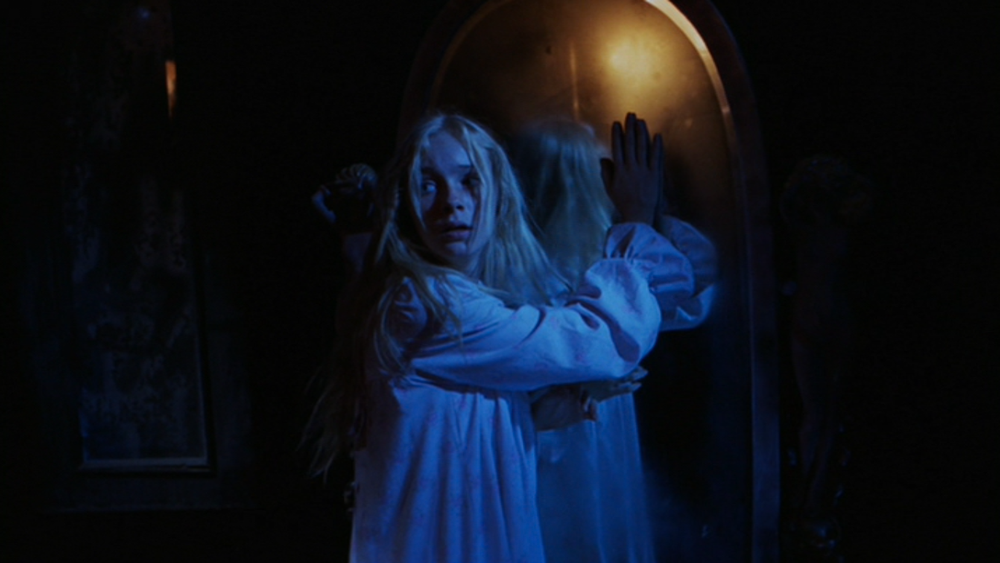
Lila is well through the looking glass here, people.
Heading back to her room, Lila runs into her father, who has transformed into a wolf-like beast. He attacks Lila, tearing at her back. Lila escapes into the kitchen, where Solange is busy cutting raw meat into regularly sized chunks. The wolf-father tears at Solange’s throat and advances on Lila, but then Lemora comes to the rescue. She sets him on fire with her torch, and the lupine Alvin Lee leaps out the window and runs into the woods. Lemora takes Lila from the kitchen, leaving Solange to twitch and moan on the floor. Lila asks what’s happened to her father, and Lemora says that sometimes when people come to stay in Astaroth, they become beast-like. When that happens, they must be destroyed. “You’ll kill my father?” Lila asks, horrified. “I have to,” Lemora insists. They embrace, which is when Lemora notices the bloody cut on the girl’s back. Lemora is entranced. She starts to suck on the wound and when Lila notices, Lemora explains: “It’s like a snakebite! I had to!”
Lemora carries Lila to bed and brushes her hair. She begins to tell her a bedtime story about a little girl who didn’t want to accept what she was, so she ran away from home. Eventually, she found her way to this very house. (Sounds familiar.) Lila asks about Mary Jo, and clearly strikes a nerve. Lemora yanks on Lila’s hair mid-brushing and demands to know who told her about Mary Jo. Mary Jo, she explains, was “just a weakling who couldn’t stand love.” Lemora then shows Lila a new dress she’d like her to wear – so many costume changes! – when they have a ceremony to make the two of them blood sisters. Lila asks if the ceremony will happen in a church, and Lemora assures it will. “Baptist?” Lila asks. “Oh no, much more ancient than that,” she replies.
The Reverend, meanwhile, continues his cross-country search of Lila. He’s since picked up a nice straw hat, but his radio is still reporting on the missing Alvin Lee – that guy is big news. In the morning, Lila hears the cloaked men retrieving the screaming boy from the stone house again. She starts to look through the drawers of the dressers in her room and finds Mary Jo’s diary. Within, Mary Jo describes life with Lemora, and it shows all the signs of an abusive relationship. Lila creeps downstairs, and all along the hallways, portraits of children seem to speak to her, whispering that she should run away. Lila sneaks out the front door, and hears Lemora talking to the boy from the stone house. She creeps up to her window and peers in on the scene. Lemora pets the boy, seated on her lap, then bites into his neck. Lemora is a vampire! Lila screams.
Lila runs from the house in her nightgown, down into a ravine, but it sounds like Lemora is in hot pursuit. It’s not Lemora, however, but one of the ghoul-men – possibly her father – with a sharpened stick. He chases Lila up into a tree. As he climbs after her, he’s grabbed and knocked down by another ghoul-man – the bus driver from earlier. While they scuffle, Lila leaves the tree and runs on. She finds a truck, surrounded by the black-cloaked vampires. These vampires are the more cat-like ones, dressed in capes and Purtian-style hats. She sneaks into the back of the truck unseen. Lemora arrives and instructs the vampires to find Lila, but then their group is attacked by a group of the more beast-like ghoul-men. The vampires and ghouls are at war, it would seem. The truck drives away during the attack and Lila, spotting a child’s coffin the truck’s rear, sees an ideal hiding spot.
The Reverend, days unshaven, continues his search and finds a town littered with vampire bodies. (Seems like he’s on the right track!) Lila’s truck arrives at its destination, and the pale-faced vampires lift the coffin out of the back. Lila leaps out of the coffin and flees into the seeming ghost town they’ve come to. The vampires carry torches – which I thought would be kind of dangerous for vampires – and comb the town for Lila. She evades them handily for quite some time, but eventually paints herself into a corner by locking herself in the upper bedroom of an abandoned house. Someone tries the doorknob, and Lila goes out the window, walking along the precarious ledge. The ledge crumbles under her feet and she falls two storeys to the ground.
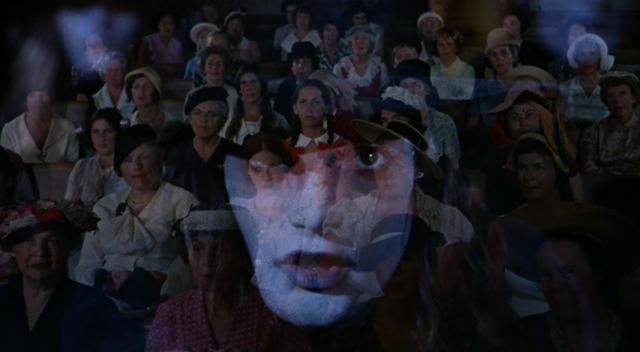
A vampire in church? Well, I thought I’d seen everything!
When Lila comes to, she hears Lemora’s voice in the darkness. Lemora insists that she wants to help her, to give her something: eternal life. Lemora then presents her with a false choice: either join her and the vampires or become one of the beastly ghouls in the woods. Lila backs away through a red curtain and finds herself in her church once again – the very same scene that opened the movie. But over top this scene, she sees the cloaked vampires, who shout at her, mock her, say that she’s been trying to seduce the Reverend. They say she is a seducer of men, wanting only to devour them. As they taunt Lila, she sees a slow-motion battle between the vampires and ghoul-men in progress in an old church. As they slowly battle, Lila’s life (or the events of the film) flash before her eyes.
When things finally stop, Lila finds herself in the old church, surrounded by the long-desiccated skeletons of the battling vampires and beast-men. Everyone is dead. Well, everyone except her monster dad, who leaps up from behind a pew and attacks his daughter. Lila desperately grabs a stake from one of the vampire’s bodies and pierces her father through the heart. Distraught over her father’s death, Lila is surprised by the entrance of Lemora, in a design-heavy new black robe, who announces that she is un-killable, and can never be stopped. She beckons Lila to come into her arms and free herself of all guilt. In Lemora’s cold embrace, Lila doesn’t notice as the vampire queen slips off her crucifix and drops it to the floor. Lemora then bares her fangs and sinks her teeth into the young girl.
The Reverend, meanwhile, has made his way to the church of the film’s climax. He calls out for Lila, stepping carefully around the corpses in the street. The Reverend falls asleep (somehow), and when he awakens, Lila is leaning over him, wearing a new vampiric cloak. She begins to gently kiss his face, and the Reverend protests – “Don’t, Lila” – before giving into his horrific lust and kissing his ward deeply. Lila then bares her brand-new fangs and the Reverend screams. The film ends where it began, with Lila back in the church choir, sining about the Rock of Ages. But was it all a dream? Or has the vampire Lila reintegrated into society?
Fangs for the hospitality, Lemora.
Takeaway points:
- Lemora is subtitled A Child’s Tale of the Supernatural, though this is not really a children’s movie. I would suggest that the subtitle alludes to the fairy-tale-like structure of the movie. Like a fairy tale, the movie has a strange, dream-like quality to it (and, at times, a dream-like logic). Additionally, it features many of the tropes of the traditional fairy tale: a missing father, a fairy godmother (though an evil one), an old witch, a quest, an imprisoned girl. There are even a few specific references to children’s stories, namely in the Lost-Boys-like adopted children of Lemora and Lila’s Alice in Wonderland dress.
- And like many fairy tales, the film seems to be a sort of warning or commentary on adolescent female sexuality. Lemora is a difficult film to interpret. Is it a coming-of-age story that insinuates young girls are secretly lustful creatures who want only to seduce men, or is it a critique of how early and inexorably society transforms girls into sex objects? Take into consideration that literally every adult – save Solange – who meets the thirteen-year-old Lila acts sexually inappropriate with her. The ticket agent leers at her, the violent drunk leers at her, the driver she secretly hitchhikes with leers at her, and – most obviously – Lemora lusts after her youthful body, whether for entirely vampire-like reasons or not. Even her guardian, the Reverend, can barely contain his lust for his pre-teen ward. And, indeed, at the end, he does not. Yet the vampires explicitly blame Lila for the way she’s treated sexually – that she wants it to happen – as does Lemora and, ultimately, the Reverend. Does that align the film with them? Or is the film showing these adults who act as if helpless against the beauty and burgeoning sexuality of Lila (who is, remember, thirteen) to demonstrate how society so readily preys on the young to satisfy its depraved desires? That Lemora treats this frankly icky issue at all makes it very timely, especially given current discussions on rock stars and their treatment of teen young groupies that have arisen in the wake of David Bowie’s death.
- Most hypnotic and appealing about Lemora: A Child’s Tale of the Supernatural is how alien the filmmaking feels. The director, Richard Blackburn is one-time feature director who made the film largely with friends as cast and crew, and as a result, Lemora doesn’t feel like most films. It doesn’t follow the same beats or three-act structure like the majority of movies. Films like this are rare – Lemora reminded me of similarly alien films like George A. Romero’s Dawn of the Dead or Alex Cox’s Repo Man – in which you really have no idea where the movie is going next, or even how far along in the story you are. It’s like watching a movie made by someone who understands filmic language, but has never seen a film before: weirdly compelling.
- Lemora’s town is called Astaroth, which is traditionally the name given to the Duke of Hell, one of the three main demons down there. Which seems like a weird thing to name your town, even in the South.
Truly terrifying or truly terrible?: Neither. Lemora has a very appealing dream-like quality to it, so that it seems like the stuff of an actual nightmare, but there are few scenes of real terror or suspense. But it’s also – despite some ham-fisted acting – far from terrible.
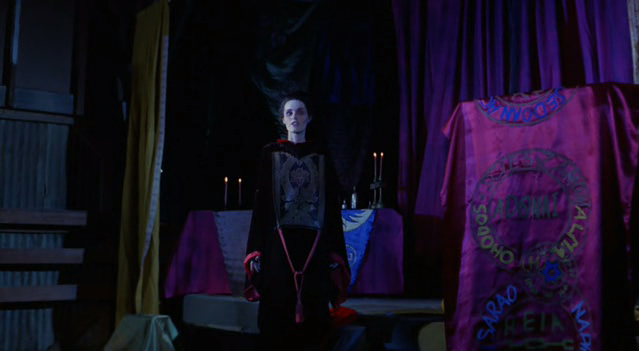
Lemora wears her best for the blood sister ceremony.
Best outfit: Lemora‘s blood-sister ceremony outfit is really fashion-forward. The robe features some very striking and intricate design work and is highlighted by red accents and trim.
Best line: “My spirit is the strongest ever. No matter by which name I am called, I am recognized as the most powerful in the hearts of all.” – Lemora, with all the confidence of a Shia Leboeuf motivational video
Best kill: So few people are killed in Lemora, it’s hard to choose a favourite death. For the most part, characters are transformed against their will – either into vampires or to beastly ghouls. But not killed. I would say Lila’s murder of her gangster-wolfman father is the best of the actual deaths.
Unexpected cameo: The hypocritical Reverend is portrayed by the film’s own director, Richard Blackburn. Cheryl Smith – Lila – later became known as “Rainbeaux” and briefly played the drums for The Runaways.
Unexpected lesson(s) learned: To put an old-timey bus in neutral, you have to exit the bus. Also, in a small Depression-era southern town, a thirteen-year-old choir singer is basically a town celebrity.
Most suitable band name derived from the movie: Astaroth Night Bus
Next up: Witchfinder General (1968).
